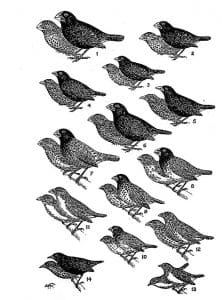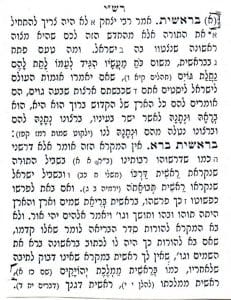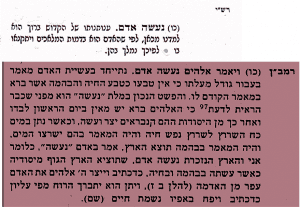by Rabbi Stanley Peerless
Bereshit (Genesis): Lesson One
The origins of life in our world have always intrigued man. It is interesting that observations of the natural world can lead to different conclusions depending on the perspective on which they are based. These conclusions can sometimes be contradictory and sometimes complementary. In this unit, we will contrast and compare the Biblical perspective on the origins of the world and the scientific perspective. But first, let us do our own observation of the living things that inhabit our planet.
There are many characteristics that identify the many species of living beings that we encounter. In this exercise, we will identify some of the significant characteristics that differentiate between different types of living beings. On the following chart, you will find two examples that will help you complete the remainder of the chart. Complete the sections for the categories listed below the examples. Add 2-4 categories of your own:
| Category | 1 | 2 | 3 | 4 | 5 | 6 |
| Locomotion | Stationary | Swim | Crawl | Fly | Walk on four legs | Walk on two legs |
| Nutrition | Water | Herbivore | Carnivore | Omnivore | ||
| Communication | ||||||
| Reproduction | ||||||
| Clothing | ||||||
| Color | ||||||
- What characteristics do human beings share with animals?
- What characteristics are unique to human beings?
- Can you think of any other characteristics that are unique to human beings?
Bereshit: Lesson Two
A young naturalist by the name of Charles Darwin was amazed by the large variety of species of birds and animals that he found on a visit to the Galapogos Islands. These islands are characterized by the fact that they are isolated from each other and demonstrate a variety of environmental factors. Darwin observed that some varieties of animals or birds occupied some islands and not others. Darwin began to collect and record data on the different species that he found in the islands. Below is a drawing of the variety of finches that Darwin found in the Galapogos Islands.
- Examine the picture and identify four variable characteristics that appear differently in different species of finches.
- What are the functions of each of these characteristics ? In what environments would these characteristics be particularly helpful or detrimental to the birds ?
- What conclusions might you draw from your observations of these birds ?
When you are done, we will compare your conclusions with those of Darwin and another scientist by the name of Lamarck.
Bereshit: Lesson Three
Attached is the first chapter of Bereshit. It has been divided into four sections as follows: p’sukim (verses) 1-10 and 14-19, 11-13, 20-25, 26-31
1)Read the entire chapter.
2) Below are a list of key words or phrases that repeat themselves throughout the chapter. Using different colored highlighters or markers, identify where these words appear in any form in this chapter:
א.ויהי
ב. ויבדל (ב-ד-ל)
ג. ויקרא
ד. וירא אלקים כי טוב
ה. ויברך (ב-ר-ך)
Which of these words and phrases can be used to characterize each section?
3) Give a title to each of the sections.
4) The Torah utilizes several different expressions to describe the creation of different things:
א. יהי
ב. תדשא
ג. ישרצו
ד. תוצא
ה. נעשה
- Find and identify these expressions in the text.
- Which of these expressions are similar to each other and which are not ? How so ?
5) Can you identify a structure in this chapter? Discuss and record what you think is the message that the Torah is communicating through that structure.
Bereshit: Lesson Four
- Draw a picture representing the creation as described in first chapter of Bereshit.
- Give a title to the picture.
- Write a commentary explaining the picture.
Bereshit: Lesson Five
The first pasuk (verse) in the Torah is very difficult both from a grammatical standpoint and in terms of content.
בראשית ברא אלקים את השמים ואת הארץ
Read through the following selections from the interpretations of Rashi and Ramban:
- What is the grammatical problem with this pasuk?
- Compare the answers of Rashi and Ramban, what is the meaning of the pasuk according to each?
- What is the function of the pasuk according to each?
- What is the function of this entire section according to each commentator?
Another problematic pasuk is 1:27:
ויאמר אלקים נעשה אדם בצלמנו כדמותינו וירדו בדגת הים וכו
- What is the grammatical problem with this pasuk?
- Compare the answers of Rashi and Ramban. What is the meaning of the pasuk according to each?
- How does the interpretation of the Ramban further clarify his interpretation of pasuk 1:1?
- Does man have a special status according to each ? How is this demonstrated in the text ?
Bereshit: Lesson Six
We are now prepared to compare and contrast the Biblical account of creation and that of evolution. Referring to the sections of the commentaries from the previous lesson, discuss how each commentator’s position is compatible or not, to the scientific theory of evolution. Are some parts less compatible than others?
The following Mishna (Sanhedrin 4:5) discusses the values that are implied in the Biblical account of creation.
- List the values that the Mishna discusses.
- Compare these values to those that we might derive from the concept of evolution.
Read the following selections from a recent Time magazine article (August 23, 1999):
Despite the protests of creationists and their intellectual allies, and such efforts as the Kansas school board’s vote last week to expunge evolution from the school curriculum, science has long taught that human beings are just another kind of animal, but most of the time this seems like a technicality. It’s not just the obvious differences—languages, civilization, technology—that set us apart. Even basic biology suggests that humanity has a special status. Virtually every other type of animal comes in multiple varieties: dozens of species of monkeys, antelopes, whales and hawks walk, swim or fly the earth, to say nothing of beetles, whose hundreds of thousands of species inspired biologist J.B.S. Haldane’s famous quip that God must have “an inordinate fondness” for them. Even our closest kin, the great apes, fall into four species, divided into several subspecies.
■ THE END OF EVOLUTION
The development of symbolic thought and complex communication did nothing less than alter human evolution. For one thing, high-tech transportation means that the world, though ethnically diverse, now really consists of a single, huge population. “Everything we know about evolution suggests that to get true innovation, you need small, isolated populations,” says Tattersall, “which is now unthinkable.”
Not only is a new human species next to impossible, but technology has essentially eliminated natural selection as well. During prehistory, only the fittest individuals and species survived to reproduce. Now strong and weak alike have access to medicine, food and shelter of unprecedented quality and abundance. “Poor peasants in the Third World,” says University of Michigan anthropologist Milford Wolpoff, “are better off than the Emperor of China was 1,000 years ago.”
How does this compare to the Biblical account ?
Bereshit: Lesson Seven
The following section (from the second chapter) also describes the process of creation. There are a number of discrepancies between the description and the description in the first chapter. Read Bereshit 1:4-25.
List the discrepancies that you can find between the two chapters and include the following:
the order of creation
the creation of man and woman
the role of man
the name used to refer to God
Draw a picture representing the creation as described in the second chapter of Bereshit.
Give a title to the picture.
Give a commentary to the picture.
Compare your picture of creation from the first chapter with that from the second chapter.
Write two short plays:
The meeting and first conversation of Adam and Eve in the first chapter.
The meeting and first conversation of Adam and Eve in the second chapter.
Choose members of the group to act out each play.





